-
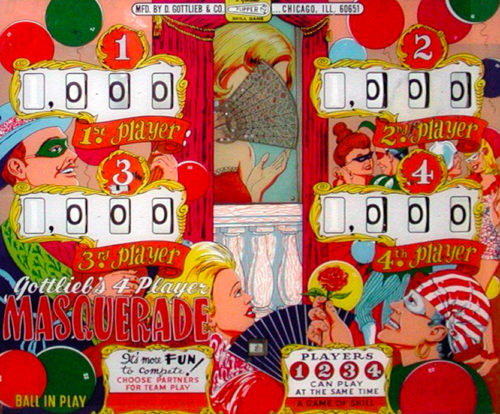
-
 Similar to Centipede, the object of the game is to destroy a millipede that advances downward from the top of the screen. The millipede travels horizontally until it either hits an obstacle or reaches the edge of the screen, after which it drops one row and reverses direction. Once it enters the player’s gray maneuvering area, it stays there and extra heads appear at intervals until both they and the millipede are destroyed. Shooting a body segment splits the millipede in two, with the rear portion sprouting its own head. A collision with any enemy costs the player one life. New enemies and gameplay elements are introduced in Millipede: Earwig: same as the scorpion in Centipede, making mushrooms poisonous so that the millipede will charge straight to the bottom of the screen after touching them. Bee: same as the flea in Centipede, dropping mushrooms in a vertical line and requiring two shots to kill. Spider: same behavior as in Centipede, bouncing irregularly across the player area and eating mushrooms. Multiple spiders can appear at the same time on higher levels. Inchworm: when hit, slows all enemies for a short period of time. Beetle: crawls around the player area for a while, then climbs up and leaves the screen, turning any mushrooms it touches into indestructible flowers. When hit, everything on the screen scrolls down one row. Dragonfly: drops mushrooms while zigzagging down, and can be destroyed with a single shot. Mosquito: bounces off the sides of the screen as it descends diagonally. When hit, everything on the screen scrolls up one row. DDT bomb (stationary): can be blown up with one shot, destroying all enemies and mushrooms within the blast radius. Whenever the mushrooms scroll down, a new bomb is added at the top of the screen. Up to four bombs can be in play at one time. The player scores points for shooting the bomb itself, as well as increased values for any enemies destroyed in the blast. All flowers and poisoned/partially destroyed mushrooms revert to normal, whole mushrooms and score points during the process when the player loses a life. At regular intervals during the game, the player will face a swarm of enemies (bees, dragonflies, etc.) instead of the usual millipede. Each enemy destroyed awards increasing points, up to a maximum of 1,000 points per enemy; this attack ends when either the entire swarm has passed or the player loses a life. Also, at intervals new mushrooms will grow on the field while others die off, in a pattern similar to Conway’s Game of Life. Players can also choose at the start of the game whether to play at an advanced level, starting with a score that is a multiple of the number of points needed to earn an extra life (by default, 15,000). The gameplay is generally much more advanced than it would be had the player started with a score of 0 and worked their way up to that point level. The maximum advanced level allowed is a function of the preceding player’s score, and games started at an advanced level where the player did not earn at least one extra life are not eligible for the high scoreboard.
Similar to Centipede, the object of the game is to destroy a millipede that advances downward from the top of the screen. The millipede travels horizontally until it either hits an obstacle or reaches the edge of the screen, after which it drops one row and reverses direction. Once it enters the player’s gray maneuvering area, it stays there and extra heads appear at intervals until both they and the millipede are destroyed. Shooting a body segment splits the millipede in two, with the rear portion sprouting its own head. A collision with any enemy costs the player one life. New enemies and gameplay elements are introduced in Millipede: Earwig: same as the scorpion in Centipede, making mushrooms poisonous so that the millipede will charge straight to the bottom of the screen after touching them. Bee: same as the flea in Centipede, dropping mushrooms in a vertical line and requiring two shots to kill. Spider: same behavior as in Centipede, bouncing irregularly across the player area and eating mushrooms. Multiple spiders can appear at the same time on higher levels. Inchworm: when hit, slows all enemies for a short period of time. Beetle: crawls around the player area for a while, then climbs up and leaves the screen, turning any mushrooms it touches into indestructible flowers. When hit, everything on the screen scrolls down one row. Dragonfly: drops mushrooms while zigzagging down, and can be destroyed with a single shot. Mosquito: bounces off the sides of the screen as it descends diagonally. When hit, everything on the screen scrolls up one row. DDT bomb (stationary): can be blown up with one shot, destroying all enemies and mushrooms within the blast radius. Whenever the mushrooms scroll down, a new bomb is added at the top of the screen. Up to four bombs can be in play at one time. The player scores points for shooting the bomb itself, as well as increased values for any enemies destroyed in the blast. All flowers and poisoned/partially destroyed mushrooms revert to normal, whole mushrooms and score points during the process when the player loses a life. At regular intervals during the game, the player will face a swarm of enemies (bees, dragonflies, etc.) instead of the usual millipede. Each enemy destroyed awards increasing points, up to a maximum of 1,000 points per enemy; this attack ends when either the entire swarm has passed or the player loses a life. Also, at intervals new mushrooms will grow on the field while others die off, in a pattern similar to Conway’s Game of Life. Players can also choose at the start of the game whether to play at an advanced level, starting with a score that is a multiple of the number of points needed to earn an extra life (by default, 15,000). The gameplay is generally much more advanced than it would be had the player started with a score of 0 and worked their way up to that point level. The maximum advanced level allowed is a function of the preceding player’s score, and games started at an advanced level where the player did not earn at least one extra life are not eligible for the high scoreboard. -
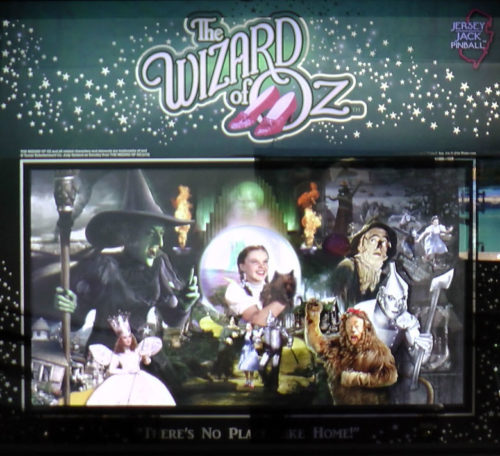 Wow! What a light show! The machine before you represents the first offering from the fledgling company of Jersey Jack Pinball of Lakewood, N.J. A pinball of any production hasn’t been made in the state for decades. This machine was created as a centerpiece of technology to show the arcade world what a contemporary machine can contain in one package. Stern, the only other U.S. maker of pinball, has always streamlined the process of pinball manufacturing and kept the number of pinball “toys” on a machine to a minimum to make their machines less expensive. Since this machine came out, Stern now offers three models of their newer machines: a stripped basic unit, an average machine contents wise and a tricked-out collectable unit to compete with the likes of Jersey Jack. Look at this machine! Mike Balcer designed the playfield; Jerry Vandersteldt, Greg Freres and Matt Riesterer penned the artwork. 1,000 units are already spoken for and both a special edition (the one here) and a standard edition are planned. Five flippers, five magnets, color changing LEDs, a 26-inch LED monitor, shaker motor, ball lift, spinning house toy, crystal ball projector, rising witch and wide-body package are only some of the innovations seen here.
Wow! What a light show! The machine before you represents the first offering from the fledgling company of Jersey Jack Pinball of Lakewood, N.J. A pinball of any production hasn’t been made in the state for decades. This machine was created as a centerpiece of technology to show the arcade world what a contemporary machine can contain in one package. Stern, the only other U.S. maker of pinball, has always streamlined the process of pinball manufacturing and kept the number of pinball “toys” on a machine to a minimum to make their machines less expensive. Since this machine came out, Stern now offers three models of their newer machines: a stripped basic unit, an average machine contents wise and a tricked-out collectable unit to compete with the likes of Jersey Jack. Look at this machine! Mike Balcer designed the playfield; Jerry Vandersteldt, Greg Freres and Matt Riesterer penned the artwork. 1,000 units are already spoken for and both a special edition (the one here) and a standard edition are planned. Five flippers, five magnets, color changing LEDs, a 26-inch LED monitor, shaker motor, ball lift, spinning house toy, crystal ball projector, rising witch and wide-body package are only some of the innovations seen here. -

-
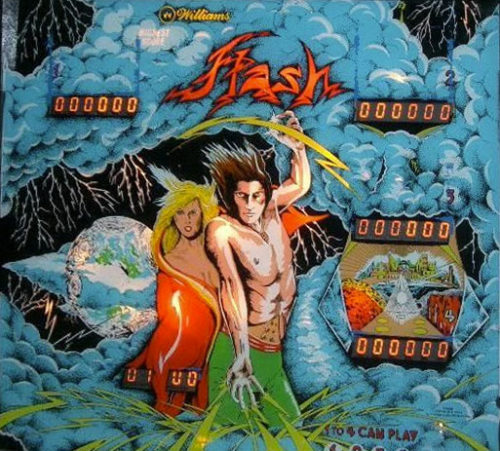 This game was a breakthru game for Williams in January. It was designed by Steve Ritchie with art by Constantino Mitchell. Flash was the first game to have a continous background sound during play and the crescendo of the sound sped up as you advanced thru the game. This is also the first game to use “flash lamps”, which are higher voltage lights that really make a presence when they light. The first thing you notice on this non-speaking game is, when you shoot the ball from the plunger, the ball travels diagonally across the playfield and ends at the top of the playfield from left to right. The top rollovers consist of 4 numbers. If you hit 1-3, you get a double bonus; all four made gives a triple bonus. 19,505 games were made, a big production run. This game also has the advance bonus eject hole, drop targets, and, of course, the bright “flash” show when activated. This game was a main staple in arcades of the ’80s.
This game was a breakthru game for Williams in January. It was designed by Steve Ritchie with art by Constantino Mitchell. Flash was the first game to have a continous background sound during play and the crescendo of the sound sped up as you advanced thru the game. This is also the first game to use “flash lamps”, which are higher voltage lights that really make a presence when they light. The first thing you notice on this non-speaking game is, when you shoot the ball from the plunger, the ball travels diagonally across the playfield and ends at the top of the playfield from left to right. The top rollovers consist of 4 numbers. If you hit 1-3, you get a double bonus; all four made gives a triple bonus. 19,505 games were made, a big production run. This game also has the advance bonus eject hole, drop targets, and, of course, the bright “flash” show when activated. This game was a main staple in arcades of the ’80s. -
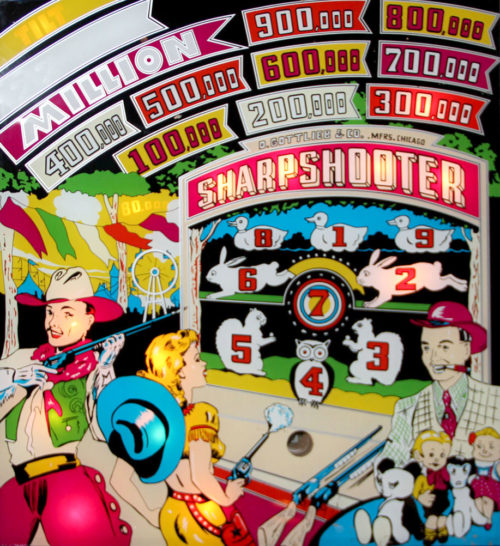 Sharp Shooter is an EM Rifle game. The shooter can choose from a variety of targets in a well-decorated range, which uses black lights to make some interesting pictures. The shooter can choose from candles, tumbling acrobats, bicycle-riding clowns, ducks and a bonus bullseye. The candles are worth 200 points; the bonus target switches from 100-200-300 points; and the other targets vary shot by shot from 30-50-100 points. The game has provisions for setting the replay score, number of shots per game and a random-miss factor and a recoil solenoid. The game also has electronic sounds such as ducks quacking.
Sharp Shooter is an EM Rifle game. The shooter can choose from a variety of targets in a well-decorated range, which uses black lights to make some interesting pictures. The shooter can choose from candles, tumbling acrobats, bicycle-riding clowns, ducks and a bonus bullseye. The candles are worth 200 points; the bonus target switches from 100-200-300 points; and the other targets vary shot by shot from 30-50-100 points. The game has provisions for setting the replay score, number of shots per game and a random-miss factor and a recoil solenoid. The game also has electronic sounds such as ducks quacking. -

-
 There are 7 Doctors, as one can plainly see from the backglass… quite conveniently, they are numbered 1-7. Each Doctor has the effect of changing the rules of one area of the Playfield, making a list of the rules all the more annoying and probably confusing. First some general information about the Doctors… there are many ways to “spot” doctors throughout the game – one is awarded at the start of any ball, and can be spotted through the Transmat target or Video Mode. At the start of a ball (or when a ball has been locked), you get to choose the “current” doctor – his picture will flash on the backglass. When a doctor- spotting shot is made, the current doctor will become solidly lit (so his attributes are carried over for the rest of the game), and the “current” doctor becomes the previously unlit doctor directly to the left of the previous one. There are 2 ways to spot all seven doctors – either go through them all one-by-one, or shoot the Emperor Daleks jackpot. Either way, all of them will be lit for the rest of the game, and you receive an additional bonus of 2OM, as well as a small animation, which plays even after a tilt! After all 7 doctors are spotted, they can be spotted a second (third, etc) time, and running through all 7 a second time awards another 2OM bonus. Also, each doctor spotted in the game (this count may be more than 7) is worth a 1M bonus at the end of the last ball (so don’t tilt it!), and this bonus (unlike the regular bonus) is multiplied by the Playfield X.
There are 7 Doctors, as one can plainly see from the backglass… quite conveniently, they are numbered 1-7. Each Doctor has the effect of changing the rules of one area of the Playfield, making a list of the rules all the more annoying and probably confusing. First some general information about the Doctors… there are many ways to “spot” doctors throughout the game – one is awarded at the start of any ball, and can be spotted through the Transmat target or Video Mode. At the start of a ball (or when a ball has been locked), you get to choose the “current” doctor – his picture will flash on the backglass. When a doctor- spotting shot is made, the current doctor will become solidly lit (so his attributes are carried over for the rest of the game), and the “current” doctor becomes the previously unlit doctor directly to the left of the previous one. There are 2 ways to spot all seven doctors – either go through them all one-by-one, or shoot the Emperor Daleks jackpot. Either way, all of them will be lit for the rest of the game, and you receive an additional bonus of 2OM, as well as a small animation, which plays even after a tilt! After all 7 doctors are spotted, they can be spotted a second (third, etc) time, and running through all 7 a second time awards another 2OM bonus. Also, each doctor spotted in the game (this count may be more than 7) is worth a 1M bonus at the end of the last ball (so don’t tilt it!), and this bonus (unlike the regular bonus) is multiplied by the Playfield X. -
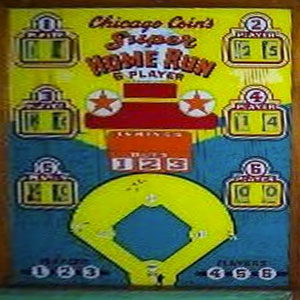
-
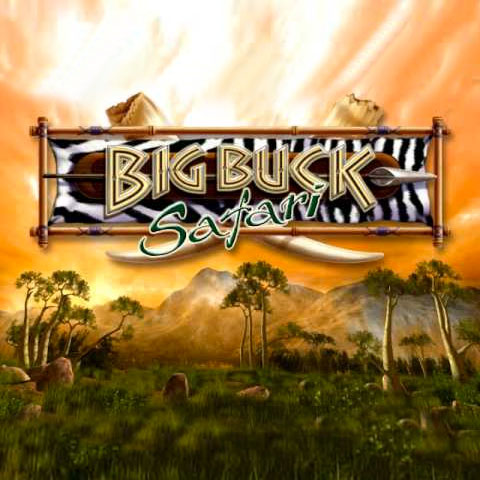
-
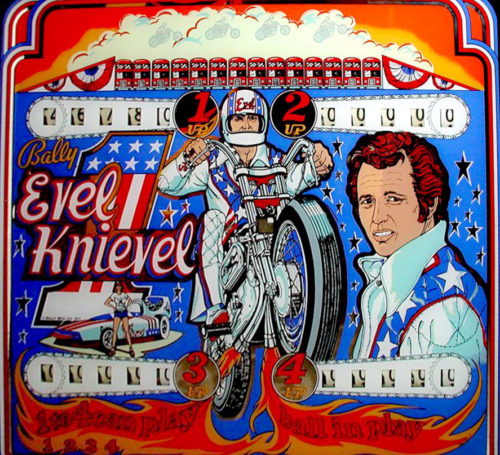 (Electromechanical Version) Bally released Evel Knievel in June of the year. Both electromechanical and solid-state versions of the game were fabricated. The reason two different platforms were made was due to the newness of the solid-state platform not being fully trusted or many arcade operators not being versed in the solid-state computerized machines. The “old faithful” mechanical versions used the same technology since the beginning of pinball that included relays, steppers, and score motors. This game was produced in mass quantity in the solid-state format with 14,000 pieces being fabricated. This game is one of only 155 made. This is probably one of the best examples of this rare run of machines. The play parallels the solid-state version, but an accumulated memory of targets hit isn’t stored in memory and awarded. This game just remembers your last hit of the last target. Enjoy!
(Electromechanical Version) Bally released Evel Knievel in June of the year. Both electromechanical and solid-state versions of the game were fabricated. The reason two different platforms were made was due to the newness of the solid-state platform not being fully trusted or many arcade operators not being versed in the solid-state computerized machines. The “old faithful” mechanical versions used the same technology since the beginning of pinball that included relays, steppers, and score motors. This game was produced in mass quantity in the solid-state format with 14,000 pieces being fabricated. This game is one of only 155 made. This is probably one of the best examples of this rare run of machines. The play parallels the solid-state version, but an accumulated memory of targets hit isn’t stored in memory and awarded. This game just remembers your last hit of the last target. Enjoy! -
Photo Booth 2 Strips of Photos – $5 THIS PHOTO BOOTH WAS AT PALACE AMUSEMENTS ! You’re standing in front of the photo booth which operated at Asbury Park’s famous Palace Amusements for nearly three decades. The Palace was a huge indoor entertainment center with hundreds of arcade games and full size rides, including a ferris wheel that extended up through the roof of the building. It was located three blocks south of here at the corner of Cookman Avenue & Kingsley Street, just west of the Casino carousel building. The site is now a parking lot. Installed by Palace owners Edward Lange and Zimel Resnik in the late 1950s or early 1960s, this photo booth delighted thousands of patrons until November 27, 1988 when the Palace closed its doors for the final time. The building sat vacant and decaying for more than 15 years until it was demolished in May 2004, despite massive public opposition and offers from local developers to save and renovate the historic 1888 structure. After the Palace closed the booth was moved to Sandy’s Arcade, which at that time was located in the First Avenue Pavilion on the Asbury Park boardwalk. Today Cubacan Restaurant occupies the arcade’s former space. Sandy’s went out of business in the early 1990s and the photo booth was put up for sale. The offering caught the attention of Slim and Pamela Smith, Jersey Shore natives who had migrated to Vermont but were vacationing near Asbury Park. The Smiths stumbled upon the closed arcade and purchased the photo booth. They moved it 342 miles north to Burlington, Vermont and installed it in their small gift shop known as “Folkheart”. Eventually the machine was moved to a second Folkheart location in the tiny village of Bristol, Vermont where it resided among Nepalese clothing, Himalayan bric-a-brac and various trinkets. For thirteen years the Palace photo booth vended pictures for the Smith’s customers. In 2003 the strobe unit which powers the flash tubes failed, and after several unsuccessful repair attempts the booth sat unused for three years. In December 2006 Folkheart went out of business. Slim and Pamela Smith knew the rich history of their beloved photo booth and wanted to see it preserved, but they could no longer keep it. They generously donated the machine to Save Tillie, a nonprofit organization made up of fans of Asbury Park, the Palace and Bruce Springsteen, dedicated to preservation of Palace artifacts. In early 2007 a Save Tillie volunteer restored the booth at an arcade in New York state, and on May 31, 2007 it was brought back home to Asbury Park. It was installed on the lower level of the Shoppes at the Arcade at 658 Cookman Avenue, where it was lovingly maintained by the nonprofit group for more than six years. In 2013 Save Tillie sold the booth. It was relocated to the Silverball Museum on December 2, 2013, where it will be preserved for the enjoyment of generations to come.